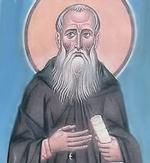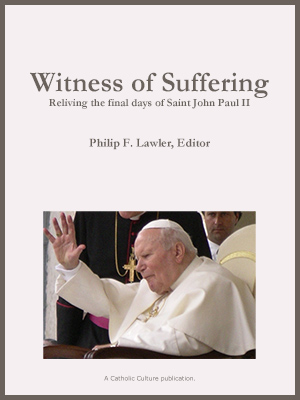The Presentation of the Lord: A Light for the Nations
By Jennifer Gregory Miller ( bio - articles - email ) | Jan 29, 2024 | In The Liturgical Year
 From the Archives, originally published in 2016:
From the Archives, originally published in 2016:
February 2nd is the Feast of the Presentation of the Lord; in the 1962 Calendar the feast is known as the Purification of Mary. This is traditionally called “Candlemas” because of the blessing of candles before Mass on this day. As I was putting my thoughts together for a post, I realized many of my thoughts were similar to my previous post on the Presentation of the Lord. I also have two posts explaining how Candlemas is not part of the Christmas season, but it does end that unofficial “Christmas Cycle.”
I will not exactly repeat myself, but I also will not apologize for not having new and improved ideas for this feast. The Church repeats the annual cycle because our human nature does not have the capacity to capture the Divine at one time. Every year we should be growing spiritually, increasing our capacity in love for Christ and His Church. The Liturgy does not change, but we should be. We are looking and listening with new ears and new eyes.
And so we return again to Candlemas In our annual cycle. When we read Scripture within the Level III atrium of the Catechesis of the Good Shepherd, I often encourage the children to listen for a word or phrase that particularly speaks to them. Perhaps we have read a passage previously, but Christ in His Word is speaking to us at this moment. What in particular are we hearing this time? My word for this feast is “Light” (which actually is a continuation of my word in my last post).
A Light to Reveal You to the Nations
So much of the liturgy for the feast of the Presentation echoes the feast of Christmas, but also expresses the expanded manifestation of Christ as celebrated on the feast of the Epiphany. Previous Infancy Narratives from the Gospel included the Canticles of Mary (Magnificat) and Zechariah (Benedictus), both speaking of the gift and glory for God’s people Israel. Simeon’s Canticle (Nunc Dimittis) echoes the Epiphany, where we celebrate how Christ came for all peoples, Jews and Gentiles: “A light to reveal you to the nations and the glory of your people Israel.”
We often take this amazing revelation for granted. When Paul writes to the Ephesians (read at Epiphany) that “that the Gentiles are coheirs, members of the same body, and copartners in the promise in Christ Jesus through the Gospel” (Eph 3:6) we sometimes forget that how groundbreaking this teaching really is! We celebrated the manifestation of Christ to the Gentiles for at the Feast of the Epiphany, and this feast reinforces this wonderful revelation! This one passage: “A light to reveal you to the nations and the glory of your people Israel” from the Canticle of Simeon is repeated throughout the Liturgy of the Mass and Divine Office. It is only one line, but it is pivotal to our Faith.
A Feast of Light
One beautiful aspect of the feasts and seasons in the Liturgy is that while a feast may focus on one aspect of Christ’s life, there are always strains of other feasts within the Liturgy of the day.
Light is a returning theme throughout the Liturgical year. It comes in a most particular way at Easter, but we also celebrate the Light of World coming at Bethlehem at Christmas. For the feast of the Presentation we celebrate Christ as the Light revealed to all nations.
Within the Catholic Culture Liturgical Year library, I have uploaded the blessing of the candles and the propers of the Mass for both the Ordinary and Extraordinary Forms. While the blessing is much longer in the older form, there are many similarities in the Liturgy. In both blessings the theme of light is not only about Christ as light, but for us being enlightened. Through this feast we are asking to be able to recognize the Light, just as the disciples recognized Jesus at Emmaus. And then this Light that we are given in the form of a lit candle is a larger symbol for us to continue our journey to the Light of Glory at the end of our lives and at Parousia.
The one simple word, light, has so much imagery to unpack, it could take a whole lifetime. The depths of the Liturgy always brings Father Virgil Michel’s words to mind:
Ancient as the hills, the liturgy is still ever new, it has ever a new store of the divine life to hold out to our grasp, and with the recurring years the realization of its meaning grows ever richer (The Liturgy of the Church: According to the Roman Rite, 1937, Dom Virgil Michel, O.S.B., Ph.D, p. 91).
Providing Light of Hope
 The timing of this feast in the Northern Hemisphere corresponds to the long winter months, when so many people are affected by the shorter spans of daylight. For most this can be a stressful time, whether one calls it mid-winter blues, cabin fever, or Seasonal Affective Disorder (S.A.D.). This a time often marked with isolation, discouragement, lack of motivation and even depression.
The timing of this feast in the Northern Hemisphere corresponds to the long winter months, when so many people are affected by the shorter spans of daylight. For most this can be a stressful time, whether one calls it mid-winter blues, cabin fever, or Seasonal Affective Disorder (S.A.D.). This a time often marked with isolation, discouragement, lack of motivation and even depression.
This feast can give us that light in the darkness on these shorter days. We are given motivation to help us move forward and keep on with our daily struggle. Christ is our Light, our companion to find that path in the darkness. This feast gives a glimpse of Easter, but also a glimpse to our eternal glory. We are given the Light and the Companion for our journey. We just need to remember to keep on taking one step forward at a time.
Let us ask Our Lady for her help. We should imitate her in taking the Light of Christ and keeping Him within our hearts. With her help we can ponder and keep that Light burning, even at those times when it seems like just a tiny ember.
For Further Reading:
- Candlemas: The Feast of Light and Hope
- A Sunday Feast: the Presentation of the Lord
- Christmas to Candlemas: When Is the Real End of the Christmas Season?
- The End of Christmas: Dispelling the Misconceptions
- Blessing of Candles and Propers of Mass
- Blessing of Candles and Propers of Mass for 1962 Missal
And for February 3, the Feast of St. Blaise, the first use of the newly blessed candles:
All comments are moderated. To lighten our editing burden, only current donors are allowed to Sound Off. If you are a current donor, log in to see the comment form; otherwise please support our work, and Sound Off!








